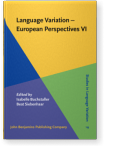Geolinguistic documentation of multilingual areas
VerbaAlpina and the challenges of digital humanities (DH)
This chapter presents the research project VerbaAlpina funded by the German Research Foundation (DFG). The project investigates the specific Alpine lexis in the multilingual Alpine region where different dialects and languages from the Germanic, Romance and Slavic language families are spoken. This chapter focuses on the methodology used to transfer analogue data from traditional linguistic atlases and dictionaries into a digital format. The method used enables, for the first time, the representation and comparison of traditional geolinguistic data within a digital and multilingual research environment open to the public realm.
Keywords: Alpine lexis, Alpine region, beta code, digitisation, digital humanities, geolinguistics, Germanic, Romance, Slavic, multilingual, transcription systems
Article outline
- 1.Introduction
- 2.VerbaAlpina – the investigation of a multilingual region
- 2.1The Alpine region as an area under investigation
- 2.2A selective and analytical exploration of the Alpine region
- 2.3The transition from traditional to modern geolinguistics
- 3.Methodology: How to combine different projects
- 3.1Different projects with different aims
- 3.2The structure of the map content
- 3.2.1Structuring the data within the database
- 3.2.2The basic type: A category for historical linguistic analysis
- 3.3The conversion of the transcription systems
- 3.3.1
Step 1: From analogue to digital data using a beta code
- 3.3.2Step 2: From beta code to IPA characters
- 4.Conclusion
-
Acknowledgements
-
Notes
-
References
References (31)
References
AIS=Jaberg, Karl, and Jakob Jud. 1928–1940. Sprach- und Sachatlas Italiens und der Südschweiz. Zofingen: Ringier.
ALD=Goebl, Hans et al. 1998–2012. Atlant linguistich dl ladin dolomitich y di dialec vejins. Wiesbaden: Reichert.
ALEPO=Telmon, Tullio. 1985–. Atlante linguistico ed etnografico del Piemonte occidentale. Torino: Regione Piemonte.
ALF=Gilliéron, Jules, and Edmond Edmont. 1902–1910. Atlas linguistique de la France. Paris: Champion.
ALI=Bartoli, Matteo Giulio et al. 1995–. Atlante linguistico italiano. Roma: Istituto Poligrafico e Zecca dello Stato.
ALJA=Martin, Jean-Baptiste, and Gaston Tuaillon. 1971–1981. Atlas linguistique et ethnographique du Jura et des Alpes du nord (Francoprovençal Central). Paris: Centre National de la Recherche Scientifique.
ALP=Bouvier, Jean-Claude, et Claude Martel. 1975–1986. Atlas linguistique et ethnographique de la Provence. Paris: Centre National de la Recherche Scientifique.
ALTR=Cordin, Patrizia. 2005. L’Archivio lessicale dei dialetti trentini. Con un CD-Rom. Trento: Dipartimento di scienze filologiche e storiche.
APV=Schüle, Ernest et al. Unpublished data. Atlas des patois valdôtains.
ASLEF=Pellegrini, Giovan Battista. 1972–1986. Atlante storico-linguistico-etnografico friulano. Padova: Istituto di Glottologia e Fonetica.
BSA=König, Werner et al. (ed.). 1996–. Bayerischer Sprachatlas. Heidelberg: Universitätsverlag Winter.
BWB=Kommission für Mundartforschung der Bayerischen Akademie der Wissenschaften. 1995–. Bayerisches Wörterbuch. München: Oldenbourg.
Crowther, Paul, and Peter Lake. 2013. Concise Guide to Databases. A Practical Introduction. London: Springer.
DRG=von Planta, Robert et al. 1939–. Dicziunari Rumantsch Grischun. Chur: Bischofberger.
FEW=von Wartburg, Walther. 1922–2004. Französisches etymologisches Wörterbuch. Eine Darstellung des galloromanischen Sprachschatzes. Bonn: Klopp.
GPSR=Gauchat, Louis, and Jules Jeanjaquet. 1924–. Glossaire des patois de la Suisse romande. Neuchâtel: Attinger.
Id.=Staub, Friedrich, and Ludwig Tobler. 1881–. Schweizerisches Idiotikon. Wörterbuch der schweizerdeutschen Sprache. Frauenfeld: Verlag Huber.
Krefeld, Thomas. 2016a. Crowdsourcing, in: VA-de 16/1, Methodologie, [URL], last accessed: 29.08.2016..
Krefeld, Thomas. 2016b. Interlinguale Geolinguistik, in: VA-de 16/1, Methodologie, [URL], last accessed: 29.08.2016.
Krefeld, Thomas, and Stephan Lücke. 2014. “VerbaAlpina – Der alpine Kulturraum im Spiegel seiner Mehrsprachigkeit.” Ladinia XXXVIII, 189–211.
Krefeld, Thomas, and Stephan Lücke. 2016. Betacode, in: VA-de 16/1, Methodologie, [URL], last accessed: 29.08.2016.
LSI=Lurà, Franco. 2004. Lessico dialettale della Svizzera italiana. Bellinzona: Centro di dialettologia e di etnografia.
Lücke, Stephan. 2016. Codepage, in: VA-de 16/1, Methodologie [URL], last accessed: 29.08.2016.
SAO=Gaisbauer, Stephan et al. 1998–. Sprachatlas von Oberösterreich. Linz: Adalbert-Stifter-Institut des Landes Oberösterreich.
SDS=Hotzenköcherle, Rudolf et al. 1962–2003. Sprachatlas der deutschen Schweiz. Bern/Basel: Francke Verlag.
SLA=Škofic, Jožika et al. (ed.). 2011–. Slovenski lingvistični atlas. Ljubljana: Založba ZRC.
SONT=Gabriel, Eugen et al. (ed.). Unpublished data. Sprachatlas von Süd-, Ost- und Nordtirol.
Thesaurus Linguae Graecae. 2015. beta code Manual (TLG): [URL] last accessed: 10.04.2017.
TSA=Klein, Karl Kurt, and Ludwig Erich Schmidt (eds.). 1965–1971. Tirolischer Sprachatlas. Innsbruck: Tyrolia-Verlag.
VALTS=Gabriel, Eugen (ed.). 1985–2000: Vorarlberger Sprachatlas mit Einschluss des Fürstentums Liechtenstein, Westtirols und des Allgäus. Bregenz: Vorarlberger Landesregierung.
WBÖ=Kranzmayer, Eberhard (ed.). 1963–. Wörterbuch der bairischen Mundarten in Österreich. Wien: Verlag der Österreichischen Akademie der Wissenschaft.
Cited by (2)
Cited by two other publications
Brown, Josh
2023.
Whose Language? Whose DH? Towards a taxonomy of definitional elusiveness in the digital humanities.
Digital Scholarship in the Humanities 38:2
► pp. 501 ff.

Romero, Marta Negro & Xandra Santos Palmou
2020.
Le Trésor du lexique patrimonial galicien et portugais : un portail pour l’étude du lexique dialectal1.
ILCEA :39

This list is based on CrossRef data as of 30 october 2024. Please note that it may not be complete. Sources presented here have been supplied by the respective publishers.
Any errors therein should be reported to them.
